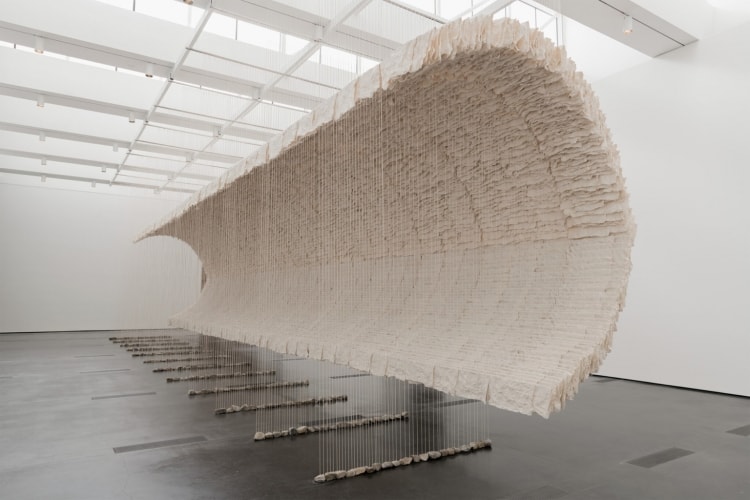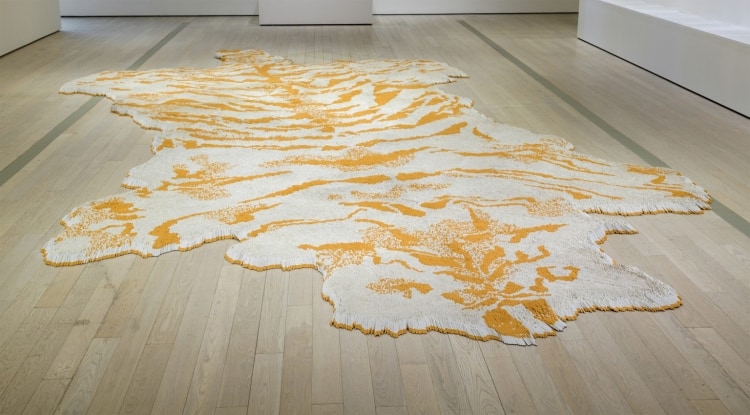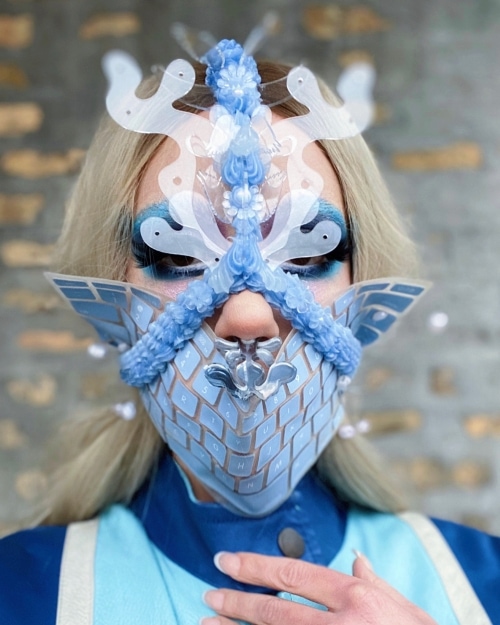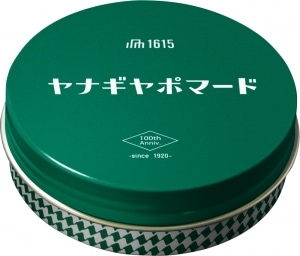WHAT HAS ONLY NOW BECOME POSSIBLE?
"Welcome to our first virtual ‘Sculpture Dialogues,’” Adrian Wong, assistant professor of sculpture at the School of the Art Institute of Chicago(SAIC), says to the small audience that has gathered on the Zoom call, mostly SAIC faculty and graduate students from the sculpture program.

Zhu Jinshi, "Wave of Materials (2007)". Installation view at the Los Angeles County Museum of Art, image © Museum Associates/LACMA.
I’m standing on the back porch of my parent’s home in the sloping, glacial hills of rural, Southeastern Michigan. My phone is at 11%, but the six-inch power cord isn’t long enough for me to place my phone on the railing, so I have it lying face up on the ground below me. I’m trying to enjoy the last bit of sun on this warm, spring day. A crescendo of croaking chorus frogs echoes from the dismal swamp just beyond the tree-lined edges of the yard. Several of my parent’s chickens are clawing through the piles of leaves that my sisters and I raked the previous evening, searching for whatever bugs didn’t flee overnight.
Shyly, I mute both the audio and video for the call, preferring to be an anonymous participant—one of the few perks of virtual events that is starting to grow on me.
“Sorry, I’m a little more nervous to be talking at my computer than I expected,” Orianna Cacchione, curator of global contemporary art at the Smart Museum of Art, says as she tries to figure out how to screen share her slideshow. She has set her Zoom background to an installation image of the Smart Museum’s The Allure of Matter: Material Art from China exhibition, so that she appears to be standing in the gallery with the artwork.
Her presentation, titled “Adapting Exhibitions: A COVID-19 Case Study,” details the complex process of planning and abrupt closing of The Allure of Matter, which was scheduled for a four-city national tour with exhibition dates at LACMA, the Seattle Art Museum, the Smart Museum of Art, Wrightwood659, and the Peabody Essex Museum. The exhibition debuted at LACMA last year, but was cut short during its Chicago run when Wrightwood659 and the Smart Museum of Art announced that they would be closing to the public on March 16 due to the coronavirus pandemic sweeping the globe.
Orianna describes how she had a “profound and excruciating experience of grief” in the aftermath of closing the exhibition.
I start pacing back and forth on the porch while listening to her speak. Her statement reminds me of the Harvard Business Review article about the anticipatory grief most of us are experiencing. Everyone that I’ve talked to in the past few weeks shares similar sentiments. The overwhelming sadness and despair for the ways of life that felt so certain before. Overnight, we have all had to adjust to radical changes in our lives with little time to process.
“Why are we doing these virtual experiences? Why are we so compelled to translate the work into a virtual format?” Orianna asks. Her tone is reproving and dissatisfied as she details the Smart Museum’s efforts to foreground pre-produced digital content on their website, organize virtual talks, and produce “weekly visits” with objects from the exhibition. She observes that there is “something so deeply unsatisfying about [virtually visiting exhibitions],” adding that the exhibition’s website traffic has decreased by 60% since the museum’s closure.

Xu Bing, "1st Class (2011)". Installation view at the Los Angeles County Museum of Art, image © Museum Associates/LACMA.
Yet, she ends her presentation by reading aloud a score prepared by dancer and choreographer Irene Hsiao for a performance planned for Wrightwood659, allowing Irene’s poetic interpretation of the exhibition to help us look at the exhibition in a new way. “Maybe what works best is not what seems obvious,” Orianna says, speculating about how we can innovatively document exhibitions in the future to encourage imagination and active audience engagement.
Her presentation is followed by a short Q&A, interrupted when Adrian has to step away for a “childcare handover issue.” He laughs it off and describes how he was teaching earlier that morning and his daughter sternly told him, “be quiet. I’m trying to paint.”
I cannot help but laugh loudly and then nervously check to make sure that my audio is still muted. These personal moments have been such a small pleasure during self-isolation, such as my co-worker's kitten mercilessly climbing into her lap and meowing to get her attention during a conference call, or another colleague’s son interrupting a check-in to show us his hand—unknowingly holding it too close to the webcam for us to see—and giddily telling us about his recent birthday.
“I’m glad to have this interspatial moment,” Bun Stout, one of the two presenting graduate students, says as they introduce their mixed reality poetry reading. I unplug my phone and use my hand to shield the glare from the sun so that I can see.
They begin to read the first of two poems. Suddenly, I notice a figure sitting behind them in the room, reclining gracefully. I squint and hold my phone close to my face in an effort to determine if it's a sculpture or a person. The figure moves, making me realize it is a person, and then disappears from the screen. The door behind them opens and Bun’s partner peers into the room for several seconds. The screen flickers. Now there is a figure sitting in front of the webcam, wearing what reminds me of a diver’s helmet. The headpiece is brightly colored, decorated with Bun’s signature, decadent appliques, and features a phone mounted where their face should be, playing what appears to be a video of the artist.
I scribble down one of my favorite lines from Bun’s first poem in my notebook: “It’ll be a good life if we live long enough to sue another landlord.” By now, it’s clear to me that they pre-recorded this performance using Zoom. They’ve started to read their second poem, titled “THE DEATH OF FOMO.”
I recognize the baby blue facemask from their Instagram post announcing the Zoom event, hovering in front of a green background that looks like grass. The mask is made from a silicone keyboard cover and is held in place by delicate, floral bands; the faint letters are barely visible because of pixelation.
“What has only now become possible? I walked naked past Buckingham Fountain,” They both ask and answer during “THE END OF FOMO,” alluding to photos that they posted earlier in the week on their Instagram.
In both images, the artist poses naked in front of the North Rose Garden of Chicago’s Grant Park with the skyline of high rise buildings behind them. The photos remind me of Boticelli’s The Birth of Venus—if Boticelli was genderqueer and painted the image after a debaucherous night of huffing poppers, guzzling shots of vodka, and throwing dollar bills at drag queens during Drag Matinee at Berlin Nightclub. The subtle allusion suggests the birth, perhaps not of a mythological deity, but of new possibilities as the ongoing global health crisis undoes our current ways of life.
On their Instagram, Bun asks again, “What has only now become possible?”
This question, rooted in optimism and not despair, is one we should ask ourselves as we look to find new, relevant methods of creating and documenting our work during uncertain times. Nothing is certain about our future and that means anything could be possible. Or, as Bun jokes, “maybe in three weeks we’ll all be looking back and saying, ‘remember when we used Zoom for everything.’”

 English
English 日本語
日本語



